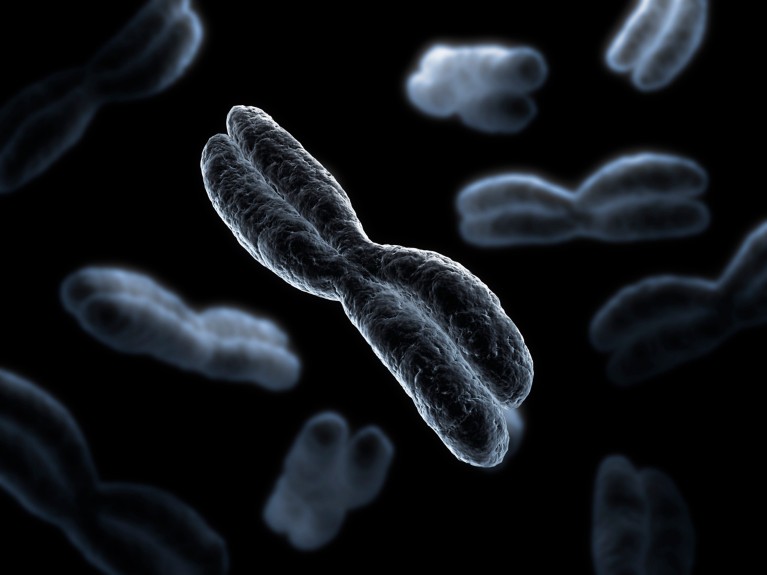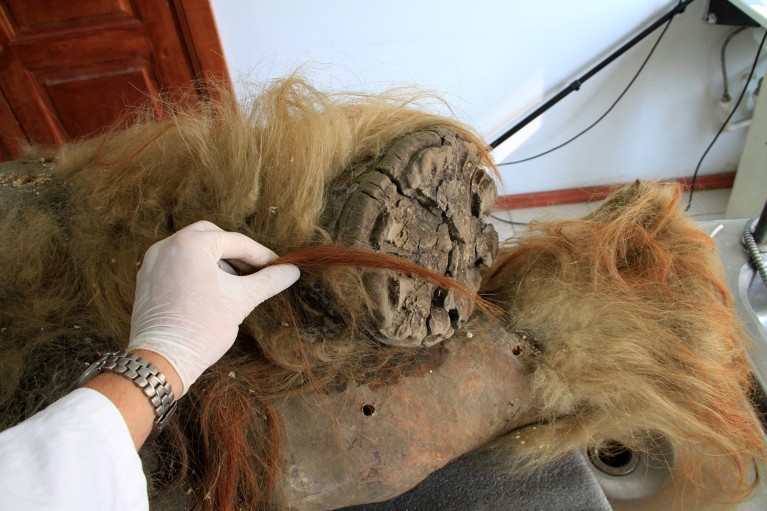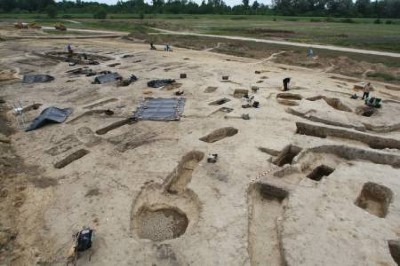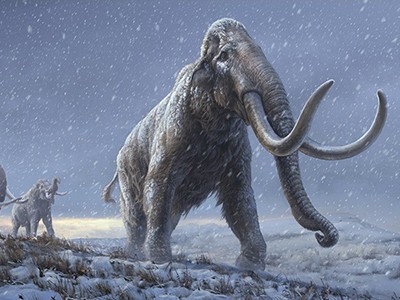
The 3D structure of chromosomes (artist’s illustration) was not thought to survive the ravages of time, but scientists examining mammoth skin have shown otherwise.Credit: SciePro/Science Photo Library
On the frozen tundra of Siberia some 50,000 years ago, a woolly mammoth met its end under mysterious circumstances. In samples of the animal’s skin, researchers have now discovered chromosomes preserved in their original 3D configuration1 — a feat previously thought impossible in ancient-DNA research.
The team also revealed the spatial organization of the mammoth’s DNA molecules and the active genes in its skin, including one responsible for giving the animal its fuzzy appearance. The work was published today in Cell.
The study is the first to report the 3D structure of an ancient genome, says Ludovic Orlando, a molecular archaeologist at Paul Sabatier University in Toulouse, France, who didn’t take part in the research. Because the spatial structure of a genome — the complete set of an organism’s genetic material — holds clues to its gene activity, understanding that structure might offer deeper insights into the cell biology of the mammoth’s skin than examining the DNA sequence alone, he says. “This work is simply unprecedented.”
Ravages of time
About 40 years ago, scientists discovered that scraps of DNA could survive in specimens from the distant past, including millennia-old Egyptian mummies. It has since become evident that in many ancient remains the DNA is preserved.
DNA from ancient graves reveals the culture of a mysterious nomadic people
But as time passes, DNA degrades and suffers chemical damage, so researchers had previously retrieved only DNA fragments that lacked a coherent structure, says study co-author Erez Lieberman Aiden, a geneticist at Baylor College of Medicine in Houston, Texas. Reconstructing a 3D genome from such pieces is nearly impossible: a mammalian genome is 30 million times the size of a typical ancient-DNA fragment, he says.
And an intact chromosome — the single, long molecule of DNA that contains part of an organism’s genetic material — is about one million times longer than most ancient-DNA fragments. Because of the assumption that the 3D structure of DNA would vanish over time, no one had attempted to study chromosome organization in the nuclei of ancient cells.
Mind-blowing discovery
Challenging that assumption, Lieberman Aiden and his colleagues embarked on a nine-year-long search for well-preserved ancient samples, eventually finding nearly intact chromosomes in 52,000-year-old skin samples from a woolly mammoth (Mammuthus primigenius) unearthed from Siberian permafrost. The discovery “was just mind-blowing”, says study co-author Cynthia Pérez Estrada, a geneticist at Baylor College of Medicine.

A researcher examines the foot of a mammoth calf retrieved from Siberian permafrost.Credit: Love Dalén, Stockholm University
The researchers analysed the structure of the mammoth’s chromosomes and revealed the folding of the DNA molecule and its spatial organization in the nucleus — two features that are crucial for determining which genes are turned on and for how long.
Comparisons with modern elephants, the mammoth’s closest living relatives, showed not only similarities in chromosome number and structure, but also differences in the activity of genes involved in hair growth and cold adaptation.
Freeze-dried DNA
The researchers proposed that mammoth chromosomes had been preserved in a glass-like state through a dehydration process similar to that used to produce beef jerky. That technique results in tissue in which DNA molecules are densely packed and immobile.
The team’s experiments on freeze-dried beef jerky, which was subjected to extreme tests including being shot with a gun and run over with a car, confirmed the researchers’ theory: the jerky shattered like glass but its chromosomes remained intact.
Million-year-old mammoth genomes shatter record for oldest ancient DNA
“In absolutely no way would one think that [ancient] DNA stays in its shape,” says Víctor Moreno Mayar, a specialist in ancient populations genomics at the University of Copenhagen, who was not involved in the study. Seeing that it can “is really cool”, he says.
The findings suggest that the potential for recovering ancient DNA extends beyond what was previously thought possible, as long as the conditions are ideal, Moreno Mayar says.
The approach in the paper could also help researchers to assemble a complete mammoth genome, says Eriona Hysolli, head of biological sciences at Colossal Biosciences, a biotechnology firm in Dallas, Texas, that is working to resurrect the woolly mammoth.
Hysolli, who wasn’t involved in the study, says that a full mammoth genome could help to reveal features that might be relevant to the company’s bold plan — producing an elephant–mammoth hybrid that resembles the extinct creature and that could be reintroduced to its natural habitat.


